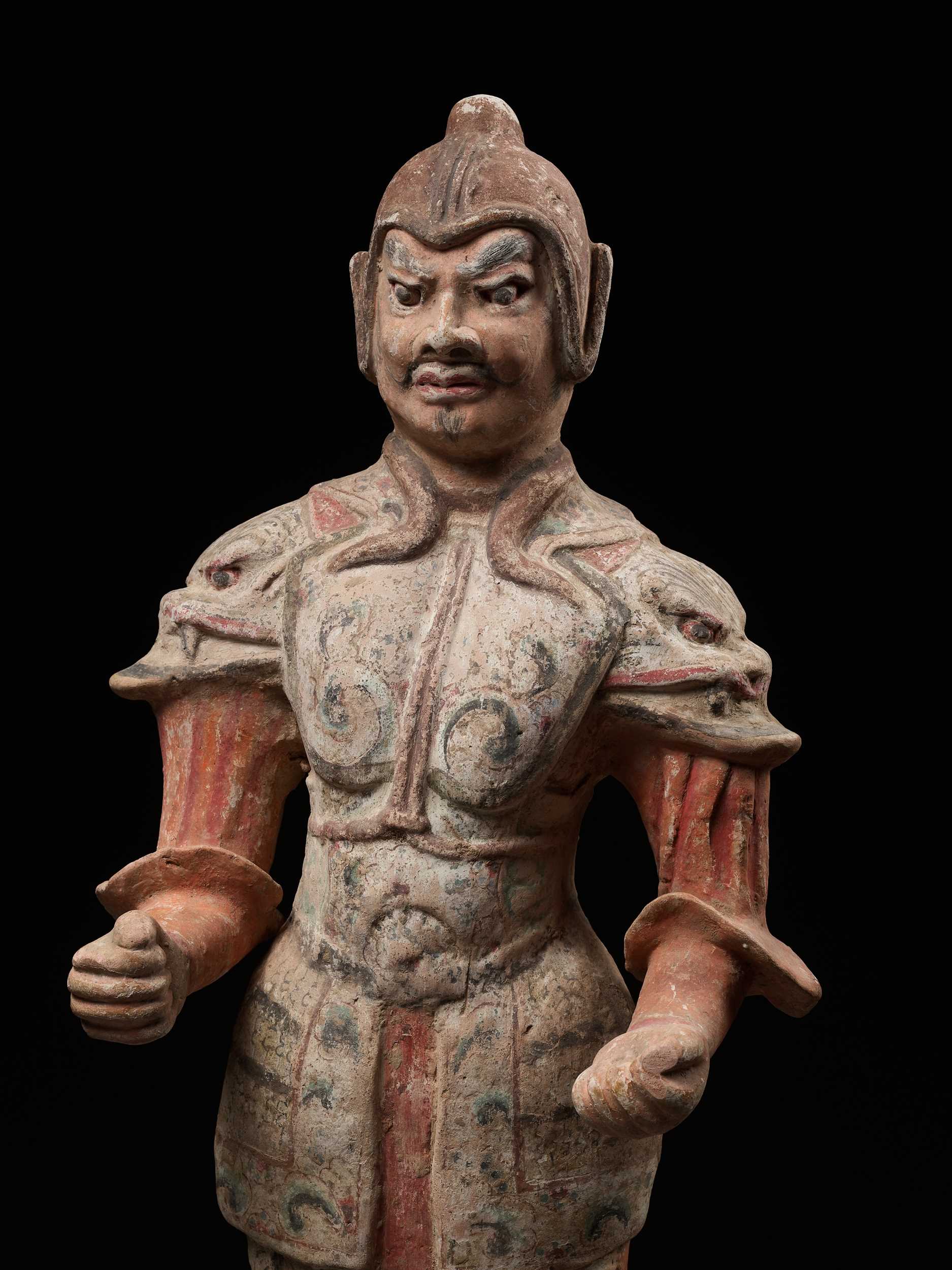A massive painted pottery model of a horse Tang Dynasty Naturalistically modelled in mid-stride on a rectangular plinth with a gracefully arched neck and a proud face conveying an alert expression detailed with bulging eyes set below a split forelock and pricked ears, pronounced jaw bones and flaring nostrils, the short tail neatly cropped and the saddle hanging over a draped blanket, the anatomy well rendered with muscular legs, covered overall with rich red and orange pigments. 87cm (37 1/4in) high. Fußnoten 唐 陶胎彩繪馬俑 The result of Oxford Authentication Ltd. thermoluminescence test no. C105j8, dated 24 March 2005, is consistent with the dating of this lot. Oxford Authentication Ltd公司熱釋光檢測結果(2005年3月24日,編號C105j8)顯示年代與本拍品年代一致。 Notable for its impressive size and naturalistically modelled in a forward moving posture with long muscular legs, pricked ears and alert expression, this massive horse, unusual for his red pigments, conveys a remarkable sense of realism which characteristics the highest standards achieved in the sculptural production of the Tang dynasty. The powerful sculpture would have been commissioned for internment in a burial belonging to an elite member of the Tang society, and together with a vast array of furnishing in the form of other animal figures, courtiers, entertainers and food and drink vessels, contributed to sustain the tomb occupant in their afterlife. For reference see J.Rawson, 'The Power of Images: The Model Universe of The First Emperor and Its Legacy', Historical Research, 2002, vol.75, no.188, pp.123-54. The frequency and exceptional sculptural quality of pottery horses dating to the Tang dynasty testifies to the importance attributed to the animal by contemporary society. Horses represented high status and wealth as only the nobility and the imperial household were allowed to ride them. The creatures were also employed in recreational activities involving dancing, polo and hunting and finally, they were considered the reward for military invasions and the foundation of imperial solidity. Galloping horses involved in the game of polo graced the tomb walls of Prince Zhang Guai (654-684 AD) in Xian, Shaanxi Province, and military parades including horses were depicted on the tomb walls of Princess Yongtai (684–701 AD) and Prince Yide (682–701 AD) also excavated in Xian. Thoroughbred horses were traded with neighbouring Arab nations for silk from as early as the Han dynasty and gradually replaced the sturdier steppe ponies indigenous to China. In 636, the Taizong emperor (r.599-649 AD) commissioned the manufacturing of six stone sculptures, each representing one of his favourite horses, which he selected from the military victories that brought him to power, and even composed a laudatory poem for each of these horses. Two closely comparable grey pottery figures of walking horses, Tang dynasty, both covered in polychrome pigments and similar in proportions to the present horse, are illustrated by V.Choi, Horses for Eternity. Terracotta Equestrian Tomb Sculpture of Dynastic China, Hong Kong, 2007, nos.96 and 99, pp.224, 226, 230-231.
A massive painted pottery model of a horse Tang Dynasty Naturalistically modelled in mid-stride on a rectangular plinth with a gracefully arched neck and a proud face conveying an alert expression detailed with bulging eyes set below a split forelock and pricked ears, pronounced jaw bones and flaring nostrils, the short tail neatly cropped and the saddle hanging over a draped blanket, the anatomy well rendered with muscular legs, covered overall with rich red and orange pigments. 87cm (37 1/4in) high. Fußnoten 唐 陶胎彩繪馬俑 The result of Oxford Authentication Ltd. thermoluminescence test no. C105j8, dated 24 March 2005, is consistent with the dating of this lot. Oxford Authentication Ltd公司熱釋光檢測結果(2005年3月24日,編號C105j8)顯示年代與本拍品年代一致。 Notable for its impressive size and naturalistically modelled in a forward moving posture with long muscular legs, pricked ears and alert expression, this massive horse, unusual for his red pigments, conveys a remarkable sense of realism which characteristics the highest standards achieved in the sculptural production of the Tang dynasty. The powerful sculpture would have been commissioned for internment in a burial belonging to an elite member of the Tang society, and together with a vast array of furnishing in the form of other animal figures, courtiers, entertainers and food and drink vessels, contributed to sustain the tomb occupant in their afterlife. For reference see J.Rawson, 'The Power of Images: The Model Universe of The First Emperor and Its Legacy', Historical Research, 2002, vol.75, no.188, pp.123-54. The frequency and exceptional sculptural quality of pottery horses dating to the Tang dynasty testifies to the importance attributed to the animal by contemporary society. Horses represented high status and wealth as only the nobility and the imperial household were allowed to ride them. The creatures were also employed in recreational activities involving dancing, polo and hunting and finally, they were considered the reward for military invasions and the foundation of imperial solidity. Galloping horses involved in the game of polo graced the tomb walls of Prince Zhang Guai (654-684 AD) in Xian, Shaanxi Province, and military parades including horses were depicted on the tomb walls of Princess Yongtai (684–701 AD) and Prince Yide (682–701 AD) also excavated in Xian. Thoroughbred horses were traded with neighbouring Arab nations for silk from as early as the Han dynasty and gradually replaced the sturdier steppe ponies indigenous to China. In 636, the Taizong emperor (r.599-649 AD) commissioned the manufacturing of six stone sculptures, each representing one of his favourite horses, which he selected from the military victories that brought him to power, and even composed a laudatory poem for each of these horses. Two closely comparable grey pottery figures of walking horses, Tang dynasty, both covered in polychrome pigments and similar in proportions to the present horse, are illustrated by V.Choi, Horses for Eternity. Terracotta Equestrian Tomb Sculpture of Dynastic China, Hong Kong, 2007, nos.96 and 99, pp.224, 226, 230-231.
.jpg)


.jpg?w=400)





.jpg)
.jpg)
.jpg)



Testen Sie LotSearch und seine Premium-Features 7 Tage - ohne Kosten!
Lassen Sie sich automatisch über neue Objekte in kommenden Auktionen benachrichtigen.
Suchauftrag anlegen